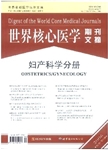多囊卵巢综合征妇女体外受精时子宫动脉血流与卵巢肾素血管紧张素系统
Uterine arterial blood flow and the substances of ovarian renin-angiotensin system in women with polycystic ovaries undergoing in vitro fertilization作者机构:Department of Obstetrics and Gynaecology University Medical Centre Ljubljanalajmerjeva 3 SI-1000 Ljubljana Slovenia
出 版 物:《世界核心医学期刊文摘(妇产科学分册)》 (Core Journal in Obstetrics/Gynecology)
年 卷 期:2006年第2卷第4期
页 面:19-19页
学科分类:1002[医学-临床医学] 100211[医学-妇产科学] 10[医学]
主 题:多囊卵巢综合征 体外受精 子宫动脉血流 卵泡液 肾素原 血清雌二醇 正常月经周期 成熟卵母细胞 临床
摘 要:Objective: To find whether plasma and follicular prorenin concentrations have any effect on the uterine arterial blood flow in women with polycystic ovarian syndrome (PCOS) compared to those with normal menstrual cycles (NMC). Study design: Controlled prospective clinical study involved 55 women undergoing in vitro fertilization: 24 with PCOS and 31with NMC. In both groups transvaginal colour Doppler assessment of uterine arterial blood flow was analysed on day 22 of the cycle, on the day of human chorionic gonadotrophin (HCG) administration and 36 h after HCG. Plasma and follicular (in the dominant follicle containing mature oocyte, and in the pooled follicles) prorenin and active renin, and serum estradiol and androstenedione concentrations were measured at these timepoints. The Student’s t-test and Pearson correlation were used for the statistical analysis. Results: The resistance index (RI) in the NMC group decreased from 0.84 ±0.05 on the day of HCG to 0.78±0.08 36 h after HCG (P 0.05); in the PCOS group the RI did not decrease. Follicular prorenin concentrations in the dominant follicle and in the pooled follicles were lower in the PCOS than in the NMC group (20,210 ±10,831 μU/l, 16,753 ±8634 μU/l versus 42,637 ±35,400 μU/l, 33,067 ±26,200 μU/l; P 0.05). Conclusions: Plasma prorenin concentrations do not affect vascular impedance to the uterine artery, but follicular prorenin do by newly formed low resistant vessels in the follicles.



